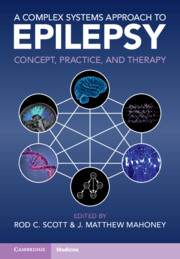Book contents
- A Complex Systems Approach to Epilepsy
- A Complex Systems Approach to Epilepsy
- Copyright page
- Contents
- Contributors
- Chapter 1 Introduction
- Chapter 2 Systems Biology Approaches to the Genetic Complexity of Epilepsy
- Chapter 3 Transcriptomic and Epigenomic Approaches for Epilepsy
- Chapter 4 Phenomenological Mesoscopic Models for Seizure Activity
- Chapter 5 Personalized Network Modeling in Epilepsy
- Chapter 6 The Baseline and Epileptiform EEG
- Chapter 7 Neuronal Approaches to Epilepsy
- Chapter 8 Mapping Epileptic Networks with Scalp and Invasive EEG
- Chapter 9 A Neuroimaging Network-Level Approach to Drug-Resistant Epilepsy
- Chapter 10 Epilepsy as a Complex Network Disorder
- Index
- References
Chapter 8 - Mapping Epileptic Networks with Scalp and Invasive EEG
Applications to Epileptogenic Zone Localization and Seizure Prediction
Published online by Cambridge University Press: 06 January 2023
- A Complex Systems Approach to Epilepsy
- A Complex Systems Approach to Epilepsy
- Copyright page
- Contents
- Contributors
- Chapter 1 Introduction
- Chapter 2 Systems Biology Approaches to the Genetic Complexity of Epilepsy
- Chapter 3 Transcriptomic and Epigenomic Approaches for Epilepsy
- Chapter 4 Phenomenological Mesoscopic Models for Seizure Activity
- Chapter 5 Personalized Network Modeling in Epilepsy
- Chapter 6 The Baseline and Epileptiform EEG
- Chapter 7 Neuronal Approaches to Epilepsy
- Chapter 8 Mapping Epileptic Networks with Scalp and Invasive EEG
- Chapter 9 A Neuroimaging Network-Level Approach to Drug-Resistant Epilepsy
- Chapter 10 Epilepsy as a Complex Network Disorder
- Index
- References
Summary
Since the early 2000s, the growing field of computational neuroscience has shown remarkable applicability in the study of epilepsy. A number of different and complementary approaches have been applied to brain signals obtained with scalp and invasive electroencephalography (EEG) to address a variety of fundamental and clinical problems. Historically, researchers have focused on overt changes in brain electrical signals, which can be detected using signal processing techniques. More recent advances have also shown that connectivity and network-level effects can provide critical information that complements the classical brain regional perspective. Thus, the modern toolkit for epilepsy electrophysiology now includes complex systems approaches such as network science (e.g., graph theory), nonlinear signal processing, information theory, and machine learning techniques. Complex systems approaches have made their contribution to our understanding of epilepsy and to the development of new tools that might improve its diagnosis and treatment.
- Type
- Chapter
- Information
- A Complex Systems Approach to EpilepsyConcept, Practice, and Therapy, pp. 99 - 126Publisher: Cambridge University PressPrint publication year: 2023



